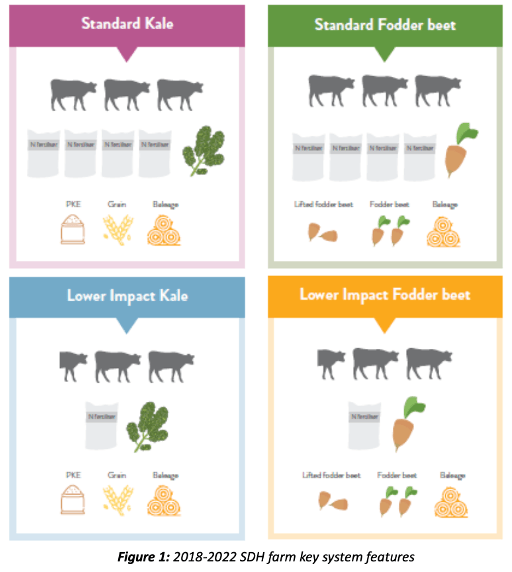4 Year Farm System
comparison; Kale vs Fodder
Beet and Standard vs Lower Nutrient loss
Comparing relative farm performance including,
Profit, Animals and Environmental measures
when farms have different wintering, or different
pasture nitrogen application rates
Timeline
2018-2022
Funder
DairyNZ
Lead
DairyNZ
Key person
Dawn Dalley

Project objectives
Understand the impact of winter crop choice on environmental loss risk, animal performance and farm profitability.
Investigate the impact of nitrogen inputs on environmental outcomes, including GHG, animal performance, people and farm profitability.
Reducing nitrate leaching by 30%.
To engage farmers in experimenting on their own farms and building confidence to adapt their management.
Project description
A four-year farm system comparison project commenced in June 2018 to address the fodder beet, wintering and nutrient loss reduction priorities identified by farmers (see Figure 1). The standard farmlets were designed to represent comparable systems with regards to N fertiliser inputs, stocking rate, supplementary feed use and wintering practices. The lower impact systems were designed to reduce N leaching by at least 30% relative to the standard system of the same winter crop type, utilising proven N loss mitigations.
Some farmlets delivered well in some areas, and under-delivered in others. Even though we expected to see a very even profit outcome across all farmlets, it was very clear that this wasn’t the case - there were undeniable pros and cons with each system.
Project outcomes/learnings
Our fodder beet systems were costlier, more complex to manage and did not produce the same milk as kale systems - a symptom which starts in early lactation and continues throughout the season.
Systems to reduce N leaching by 30% reduced profit much more than we expected, but also delivered significant reductions in GHG emissions.
Focusing on key drivers of reproductive performance resulted in more predictable reproductive outcomes for the standard kale systems, but less predictable performance for the low impact and standard fodder beet farmlets (sometimes great, sometimes bad and always unexpected).
We are confident we can deliver significant reductions in nitrogen loss and GHG emissions in the lower impact farmlets, due principally to the reduction in total feed eaten and reduced nitrogen surplus.
One year for a system will not tell the whole story. System performance will vary over time and performance (positive or negative) may compound over years.

